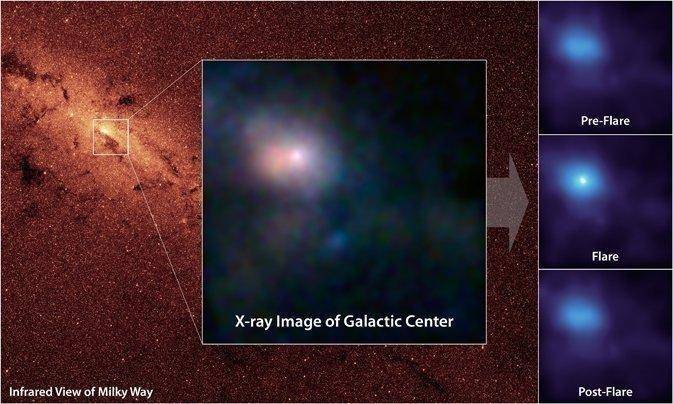NASA’s newest set of X-ray eyes in the sky, the NuclearSpectroscopic Telescope Array (NuSTAR), has caught its first look atВ the giant black hole parked at the center of our galaxy. TheВ observations show the typically mild-mannered black hole during theВ middle of a flare-up.
“We got lucky to have captured an outburst from the black hole duringВ our observing campaign,” said Fiona Harrison, the mission’s principalВ investigator at the California Institute of Technology (Caltech) inВ Pasadena. “These data will help us better understand the gentle giantВ at the heart of our galaxy and why it sometimes flares up for a fewВ hours and then returns to slumber.”
The new images can be seen by visiting:
https://www.nasa.gov/nustar
NuSTAR, launched June 13, is the only telescope capable of producingВ focused images of the highest-energy X-rays. For two days in July,В the telescope teamed up with other observatories to observe
Sagittarius A* (Sgr A*), the black hole at the center of the MilkyВ Way. Participating telescopes included NASA’s Chandra X-rayВ Observatory, which sees lower-energy X-ray light; and the W.M. Keck
Observatory atop Mauna Kea in Hawaii, which took infrared images.
Compared to giant black holes at the centers of other galaxies, Sgr A*В is relatively quiet. Active black holes tend to gobble up stars andВ other fuel around them. Sgr A* is thought only to nibble or not eat
at all, a process that is not fully understood. When black holesВ consume fuel — whether a star, a gas cloud or, as recent ChandraВ observations have suggested, even an asteroid — they erupt withВ extra energy.
In the case of NuSTAR, its state-of-the-art telescope is picking upВ X-rays emitted by consumed matter being heated up to about 180В million degrees Fahrenheit (100 million degrees Celsius) andВ originating from regions where particles are boosted very close toВ the speed of light. Astronomers say these NuSTAR data, when combinedВ with the simultaneous observations taken at other wavelengths, willВ help them better understand the physics of how black holes snack andВ grow in size.
“Astronomers have long speculated that the black hole’s snackingВ should produce copious hard X-rays, but NuSTAR is the first telescopeВ with sufficient sensitivity to actually detect them,” said NuSTARВ team member Chuck Hailey of Columbia University in New York City.
NuSTAR is a Small Explorer mission led by Caltech and managed byВ NASA’s Jet Propulsion Laboratory in Pasadena for NASA’s ScienceВ Mission Directorate in Washington. Orbital Sciences Corporation ofВ Dulles, Va., built the spacecraft. Its instrument was built by aВ consortium including Caltech; JPL; the University of California (UC)В Berkeley; Columbia University; NASA’s Goddard Space Flight Center inВ Greenbelt, Md.; the Danish Technical University in Denmark; LawrenceВ Livermore National Laboratory in Livermore, Calif.; and ATK AerospaceВ Systems of Goleta, Calif.
NuSTAR’s mission operations center is at UC Berkeley, with the ItalianВ Space Agency providing an equatorial ground station located atВ Malindi, Kenya. The mission’s outreach program is based at SonomaВ State University in Rohnert Park, Calif. Goddard manages NASA’sВ Explorer Program. Caltech manages JPL for NASA.
For information about NASA and agency programs, visit:В https://www.nasa.gov
В
В

